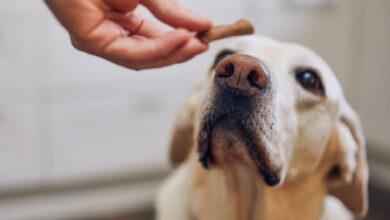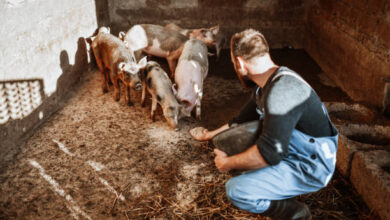
Can Food Cause Anal Gland Issues in Dogs? A Comprehensive Guide
Is your dog scooting or licking its rear end excessively? Anal gland issues might be to blame, and surprisingly, diet can play a significant role. In this guide, we’ll explore how food can cause anal gland issues in dogs and what you can do to keep your furry friend healthy and comfortable.
Understanding Anal Gland Issues in Dogs
Anal glands are small sacs located on either side of a dog’s anus. These glands secrete a smelly fluid that dogs use to mark their territory. When functioning properly, the anal glands are naturally expressed during defecation. However, issues arise when these glands become impacted or infected, leading to discomfort and other symptoms.
Location and function: Anal glands are located at the 4 and 8 o’clock positions around the anus.
Common symptoms: Scooting, licking the anal area, swelling, and discomfort.
Causes: Genetics, obesity, and diet can contribute to anal gland issues.
How Diet Impacts Anal Gland Health
Certain foods can influence the health and function of a dog’s anal glands. Here’s how:
Importance of fibre: Fiber helps bulk up the stool, making it easier for the anal glands to express naturally during bowel movements.
Role of fat: High-fat diets can lead to softer stools, which may not provide enough pressure to express the anal glands properly.
Allergens and intolerances: Ingredients like wheat, soy, corn, and certain proteins can cause inflammation and exacerbate anal gland issues.
Foods That May Cause Anal Gland Issues
Certain foods can contribute to anal gland problems in dogs by leading to softer stools, inflammation, or inadequate bowel movements. By understanding which foods may cause these issues, you can make informed decisions about your dog’s diet to help prevent discomfort and health problems. Here are some common culprits:
- Low-Fiber Diets
A diet lacking sufficient fibre can result in softer stools that don’t adequately press on the anal glands during defecation, leading to incomplete emptying of these glands. Here are some examples of low-fiber foods that might cause issues:
Processed Foods: Many commercial dog foods, especially lower-quality ones, contain fillers and low-fiber ingredients such as by-products, corn, and soy. These foods might be convenient, but they often lack the necessary fibre content to promote healthy bowel movements.
White Rice and Pasta: While these can be part of a balanced diet in moderation, relying heavily on white rice or pasta can reduce the overall fibre intake. These foods do not provide the bulk needed to help express the anal glands naturally.
Bread and Other Baked Goods: Human foods like bread, cakes, and pastries are typically low in fibre and high in carbohydrates and fats, which can contribute to softer stools.
- High-Fat Foods
Dietary fat is essential for your dog’s health, but excessive amounts can lead to softer stools, making it difficult for the anal glands to be expressed properly. Here are some high-fat foods to be cautious of:
Fatty Meats: Cuts of meat that is high in fat, such as bacon, pork belly, and certain beef cuts, can contribute to anal gland issues. These foods can also cause weight gain, which is another risk factor for anal gland problems.
Dairy Products: Foods like cheese, butter, and whole milk are high in fat. While some dogs can tolerate small amounts of dairy, too much can lead to digestive issues and softer stools, impacting anal gland health.
Fried Foods: Any food that is fried is typically high in fat. These should be avoided not only because of their impact on anal glands but also due to their overall negative effects on canine health.
- Common Allergens
Food allergies and intolerances can cause inflammation in the digestive tract, which may lead to issues with anal glands. Identifying and avoiding these allergens can help maintain your dog’s anal gland health:
Wheat: A common ingredient in many dog foods, wheat can cause allergic reactions or intolerances in some dogs, leading to gastrointestinal inflammation and softer stools.
Soy: Another common allergen, soy, can contribute to digestive problems and inflammation. It’s often used as filler in lower-quality dog foods.
Corn: While not inherently bad, corn is a frequent allergen and is used extensively in commercial dog foods. It can cause digestive upset and contribute to inflammation in susceptible dogs.
Certain Proteins: Some dogs may develop allergies to specific proteins such as chicken, beef, or lamb. These allergies can cause digestive inflammation, leading to issues with anal glands.
- Additional Considerations
Artificial Additives: Preservatives, artificial colours, and flavours in commercial dog foods can cause digestive issues and contribute to anal gland problems. Opting for natural, additive-free foods can help reduce this risk.
Low-Quality Dog Foods: Many lower-quality dog foods use fillers and by-products that do not provide adequate nutrition and fibre. Investing in higher-quality, well-balanced dog food can make a significant difference in your dog’s overall health, including anal gland function.
YOU MAY LOVE TO READ:
Can Rabbits Eat Grapes? Everything You Need to Know
What Do Baby Rabbits Eat? A Guide to Healthy Bunnies
Recommended Diet for Preventing Anal Gland Issues
A well-balanced diet plays a crucial role in maintaining your dog’s anal gland health. Incorporating high-fiber foods, lean proteins, and anti-inflammatory ingredients can help prevent anal gland issues and keep your dog comfortable. Here’s a detailed look at what to include in your dog’s diet:
- High-Fiber Foods
Fibre is essential for producing firm, bulky stools that help naturally express the anal glands during defecation. Here are some excellent high-fiber food options for your dog:
Pumpkin: Rich in soluble fibre, pumpkin helps bulk up stools and regulate bowel movements. It is also gentle on the digestive system, making it a great addition to your dog’s diet. You can add a few tablespoons of canned pumpkin (without added sugar or spices) to their regular meals.
Sweet Potatoes: Packed with dietary fibre, sweet potatoes aid in digestion and stool formation. They are also a good source of vitamins A, C, and B6. You can serve them cooked and mashed, but avoid adding any seasoning or sugar.
Carrots: High in fibre and low in calories, carrots are great for maintaining anal gland health. They also provide beta-carotene, which is beneficial for your dog’s vision and immune system. You can offer them raw as a crunchy snack or cooked and mixed into their food.
Brown Rice: This whole grain is a good source of fibre and is easily digestible for most dogs. Brown rice can be a staple in your dog’s diet, mixed with lean proteins and vegetables to create a balanced meal.
- Lean Proteins
Protein is vital for your dog’s overall health, but it’s important to choose lean sources to avoid excessive fat that can lead to softer stools and potential anal gland issues. Consider the following lean protein options:
Chicken: Skinless, boneless chicken breasts are an excellent source of lean protein. They are easy to cook and can be added to your dog’s regular meals. Avoid feeding your dog chicken skin, as it contains a lot of fat.
Turkey: Another lean protein, turkey is similar to chicken in its benefits. Use skinless, boneless turkey breasts or ground turkey that is labelled lean or extra lean. Ensure its cooked thoroughly without any added seasoning.
Fish: Fish like salmon, whitefish, and cod are not only lean but also provide beneficial omega-3 fatty acids, which have anti-inflammatory properties. Cook the fish thoroughly and ensure there are no bones before serving it to your dog.
- Anti-Inflammatory Ingredients
Incorporating anti-inflammatory ingredients into your dog’s diet can help reduce inflammation and support overall anal gland health. Here are some beneficial options:
Fish Oil: Rich in omega-3 fatty acids, fish oil helps reduce inflammation and supports skin and coat health. You can add fish oil supplements to your dog’s diet, but consult your vet for the appropriate dosage.
Flaxseed: Another good source of omega-3 fatty acids, flaxseed also provides dietary fiber. You can sprinkle ground flaxseed on your dog’s food or mix it into homemade treats.
Turmeric: Known for its powerful anti-inflammatory properties, turmeric can be a great addition to your dog’s diet. You can add a small amount of turmeric powder to their food. However, consult your vet for the correct dosage, as too much turmeric can cause digestive upset.
Additional Tips for Implementing a High-Fiber Diet
Transitioning your dog to a high-fibre diet should be done gradually to avoid digestive issues. Here are some tips to ensure a smooth transition:
Introduce Fiber Slowly: Start by adding small amounts of high-fiber foods to your dog’s diet and gradually increase the quantity over a week or two. This helps your dog’s digestive system adjust without causing discomfort or diarrhoea.
Monitor Your Dog’s Response: Keep an eye on your dog’s stool consistency and overall behaviour. Firm, well-formed stools indicate that the high-fiber diet is working. If you notice any adverse reactions, such as diarrhoea or constipation, adjust the diet accordingly and consult your vet.
Stay Hydrated: Ensure your dog has access to plenty of fresh water, as fibre absorbs water and can lead to dehydration if not balanced with adequate fluid intake.
Balanced Diet: While fibre is important, make sure your dog’s diet remains balanced with the right amounts of protein, fats, vitamins, and minerals. A balanced diet supports overall health and prevents other nutritional deficiencies.
When to Consult a Veterinarian
It’s important to know when to seek professional help for your dog’s anal gland issues:
Persistent symptoms: Continued scooting, licking, or swelling despite dietary changes.
Blood or pus: The presence of blood or pus in the stool or around the anus indicates an infection.
Behavioral changes: Lethargy, loss of appetite, or signs of pain.
Conclusion
By understanding how food can cause anal gland issues in dogs, you can take proactive steps to keep your furry friend healthy and comfortable. Whether it’s adjusting their diet to include more fibre or avoiding certain allergens, small changes can make a big difference.
Evaluate your dog’s diet today and make the necessary changes to prevent anal gland issues. Share your experiences and tips in the comments below, and help other pet owners by sharing this post on social media.




